Toilet Flush Valve- How it Works, Types, Sizes, Replacement
Last Updated on August 8, 2023 by toilethaven
What is a Toilet Flush Valve?
A flush valve is the toilet part at the bottom of the tank through which water flows from the tank to the bowl during flushing. Most toilets have a 2-inch flush valve, but a few high-performance ones have a 3 or 4-inch flush valve.
Flush valves are attached to the toilet tanks by a lock nut underneath the tank. A toilet tank-to-bowl gasket, also known as a spud washer, is installed at the bottom of the flush valve covering the entire lock nut.
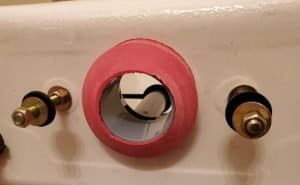
The toilet tank-to-bowl gasket creates a water-tight seal between the tank and the bowl. When you notice your toilet leaking between the tank and the bowl after flushing, the gasket is not sealing.
Inside the tank, the toilet flapper sits on top of the flush valve opening, creating a water-tight seal. This allows the toilet tank to always be full and ready for use.
The flush valve has two pegs where the toilet flapper ears are hooked. It, therefore, provides a medium for hinging the flapper.
How a Flush Valve Works
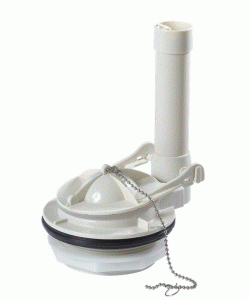
In order to understand how a flush valve works, it helps also to have an understanding of how the toilet works as a whole. A toilet has two mechanisms: the flushing mechanism and the refill mechanism.
The flushing mechanism involves the toilet handle, arm, lift chain, toilet flapper, flush valve, bowl, and trap.
The refill mechanism starts with the fill valve, then the toilet float, the refill tube, and the overflow tube.
- When you push the toilet handle down, the lift chain, which until that moment was slack, is pulled up by the handle arm.
- The lift chain, in return, lifts the toilet flapper off the flush valve.
- Water flows from the tank to the bowl via the flush valve.
- Releasing the toilet handle relaxes the lift chain, and the flapper falls back and seals the flush valve.
- The fill valve starts to refill the tank.
- As the fill valve fills the tank, the refill tube sends some water down to the bowl through the overflow tube (connected to the flush valve)
The overflow tube is the large tube in the middle of the toilet tank. It is connected to the flush valve. The refill tube is clipped on top of the overflow tube. It sends some water to the bottom of the bowl, which acts as a barrier for sewer gases.
If the fill valve is defective and continuously fills the tank, the overflow tube also channels the excess water down to the bowl to avoid overflowing. The water level in the tank should be ½ inch below the overflow tube.
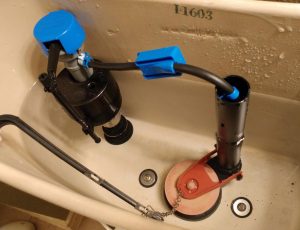
Flush Valve Sizes
Before the introduction of low-flow toilets, flush valve sizes did not matter much. Almost all toilets had a standard 2-inch flush valve. Back then, the toilets used 3.5 gallons of water per flush, so your toilet would still flush well, even with a small flush valve.
Low-flow toilets use 1.6 gallons of water per flush or less. Although a 1.6 GPF toilet can still flush well using a 2-inch flush valve, toilet manufacturer engineers had to look for a way of having a powerful flushing toilet while using even less water.
And that is how 3 and 4-inch flush valves came to be. The trick to getting a powerful flush lies in how you deliver the water to the bowl. How fast you do it.
If you dump the water in the bowl quickly, you will have a powerful flush. A toilet like the American Standard Champion 4 has a 4-inch flush valve. As a result, it is one of the most powerful flushing toilets.
While replacing your flush valve, you will need to buy the exact size, or else you will be left with a valve you can’t use.
The best flush valve to buy is an original replacement from your toilet tank manufacturer. Get your toilet model number stamped inside your toilet tank and use it to order a flush valve
Fluidmaster also has great universal flush valves.
Types of Flush Valves
You are most likely to come through 4 types of flush valves:
- Standard flush valves
- Canister flush valves
- Flushometers
- Dual-flush valves
Standard Flush Valves
These are the most common types of flush valves. They come with single-flush toilets and use a toilet flapper seal.
The toilet tank can use a float ball or a float cup with a standard flush valve. It does not occupy a large space inside the toilet tank.
This kind of flush valve is cheaper to replace. It is also way easier to clean if mineral deposits or debris inhibit the flapper seal.
Tower Style/Canister Flush Valve
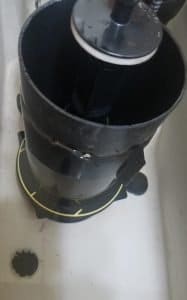
Canister flush valves are mounted in the middle of the toilet tank. Modern Kohler toilets like the Kohler Cimarron especially use them.
A cylindrical canister valve with a rubber seal/gasket at the bottom is attached to a chain which is in turn connected to the flushing handle. When you push the toilet handle down, the chain lifts up the canister allowing water to flow down to the bowl.
Unlike in a standard flush valve where the flapper is hinged to one side, a canister flush valve lifts off wholly, allowing water to flow down to the bowl through a 360 degrees angle.
This design allows water to flow to the bowl faster, resulting in a powerful flush.
Flushometer
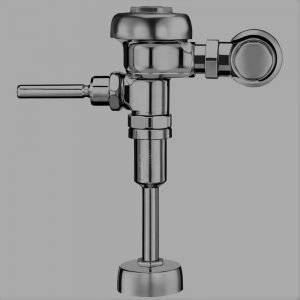
A Flushometer is a commercial flush valve. It is used with tankless toilets. Tankless toilets, as the name suggests, are toilets that have no tanks and which also do not flush automatically.
They are supplied with water under high pressure, enough to flush the toilet, and therefore do not need a tank. Remember, the reason you have a tank is that water in most buildings does not have sufficient pressure to flush a toilet.
Flushometers are mostly found in urinals and public toilets. They release a metered amount of water every time you push the button.
Dual-Flush Valves
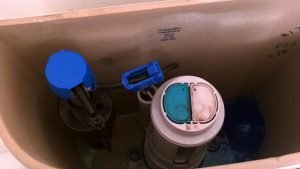
Dual-flush valves are found in dual-flush toilets. A dual flush toilet is a toilet that gives the user the option of using less water for flushing liquids or a little bit more water for flushing solids.
Dual flush toilets almost always use flush buttons. The buttons are located at the top of the tank lid. Just like the canister flush valves, dual flush valves are mounted in the middle of the toilet tank.
When you push any button, the dual flush valve seal lifts off, allowing water to flow down to the bowl.
How Do You Know in Your Flush Valve is bad?
- Toilet running constantly- When you have a constantly running toilet, most of the time, it is caused by a faulty toilet flapper, but sometimes it is a result of a cracked flush valve.
- Toilet leaking between the tank and the bowl – When this happens, it is a sign that the flush valve is cracked or the toilet tank to bowl gasket is leaking. A wobbly toilet tank could also cause it.
How to Replace a Flush Valve
Replacing a flush valve involves removing the toilet tank, replacing the valve, and then installing the tank. Although it looks like too much work, it is a simple task you can easily do without calling a plumber.
While replacing the flush valve, it is a good practice also to take the opportunity to replace the toilet tank bolts, tank-to-bowl gasket, and toilet flapper.
Toilet tank repair kits are available and cheaper than buying one part at a time. A new kit can serve you for the next five or more years.
This is a detailed guide on how to replace a flush valve.
A new flush valve costs between 10 and 20 dollars.